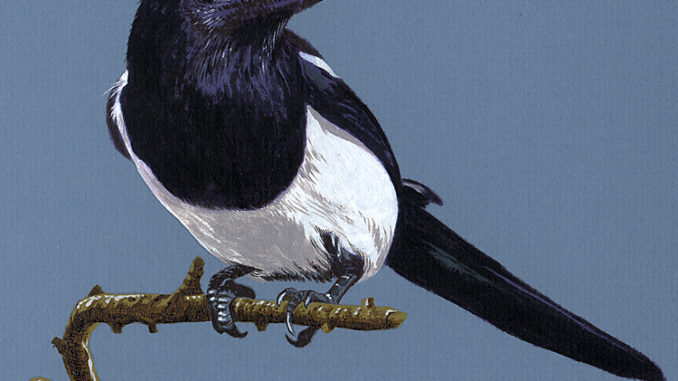
By R. Gary Raham
The western black-billed magpie, Pica hudsonia, with his tuxedo-like black and white coloring, long tail, and extrovert’s belligerence, quickly impressed me when I first moved to Colorado from the Midwest. Like people, magpies (and other members of the crow family) will eat nearly anything, hang out together in intimidating mobs, and use their intelligence to take advantage of any opportunity. Author Boria Sax once said, “Crows often give an impression of sublime indifference to people, as though waiting patiently for the era of human beings to pass.”
Perhaps magpies, and birds in general, now considered being the last shrunken remnants of the dinosaur clan, are waiting for this whole “mammal fad” of the last 65 million years to pass. They may figure a critter doesn’t need hair, breasts, and inflated brains to take advantage of the planet’s bounty. Magpies use social skills and versatility to keep one step ahead of adversity.
For one thing, magpies aren’t picky about what they eat. They spent the ice ages eating ticks and beetles off the backside of giant bison and other megafauna. They will eat small mammals and other birds, along with their eggs and hatchlings. They will also devour fruits, nuts, and various grains as they come into season. Magpies will follow coyotes around to share what table scraps they can find and deftly dart in and out of traffic to sample road kill. They will even hang around eagles and other potential predators in groups of two or three and play successful games of “pester and steal.” One magpie will divert a predator’s attention long enough for another to snatch a choice morsel of food. Magpies and other corvids will also act collectively to “mob” raptors and other predators, to lessen the chances of becoming some other critter’s meal.
Black-billed magpies tend to stick with the same mate for one or more years. They build 48” high X 40” wide complex dome-shaped nests that can take up to 40 days to construct. They will nest in open woodlands, thickets near a river, in fields, trees, shrubs, or even deserted buildings. Females usually tend to the interior, lining the cup-shaped nest chamber with grass and mud, while males embellish the roof with a canopy of sticks. When a pair finishes their efforts they mate and the female produces 6 to 9 eggs. The male stands guard to make sure his paramour doesn’t dally with a neighbor.
A Cornell website (http://www.allaboutbirds.org/guide/black-billed_magpie/lifehistory) notes what has been called “funeral behavior” in magpies. When one magpie finds the remains of a comrade, he or she will begin calling loudly, sometimes attracting up to forty other magpies. The birds remain around the corpse for 10 to 15 minutes, commiserating with loud chatter, before silently flying off to other duties.
Magpie bravado includes a swaggering strut and a stretch display in males that includes waving their bills in the air and flashing white eyelids. Aggressive birds may flick or quiver their wings to display intimidating white wing patches. During courtship, magpies may spread their long tails enticingly. Females looking for companionship often beg for food.
Magpies and other blackbirds rank high on various intelligence tests. New Caledonian crows named Abel and Betty proved adept at using and fashioning hooks out of wire to raise a basket of food within a tube so they could reach the meal. Bernd Heinrich, a long-time student of Ravens, has demonstrated the birds’ ability to both use tools and recognize individual humans and what to expect of them during future encounters. Alex Kacelnik, who worked with the New Caledonian Crows, ranks them second to chimpanzees in their ability to use tools.
In 2008, some British magpies passed another test that so far had only been passed by apes, elephants, and dolphins: the ability to recognize themselves reflected in a mirror. Such self-recognition is considered a hallmark of intelligence and magpies manage the feat with a brain the size of a pea.
That magpie sizing you up took a very different path to the park bench. While humans and chimps are only separated by some 250,000 generations, we last shared a common ancestor with the magpie some 170,000,000 generations ago.
Arthur Savage, author of an entertaining book called Bird Brains, sums things up nicely: “Perhaps all birds are smarter than we are used to thinking. In the end, being called a bird brain may be a compliment.”
Support Northern Colorado Journalism
Show your support for North Forty News by helping us produce more content. It's a kind and simple gesture that will help us continue to bring more content to you.
BONUS - Donors get a link in their receipt to sign up for our once-per-week instant text messaging alert. Get your e-copy of North Forty News the moment it is released!
Click to Donate